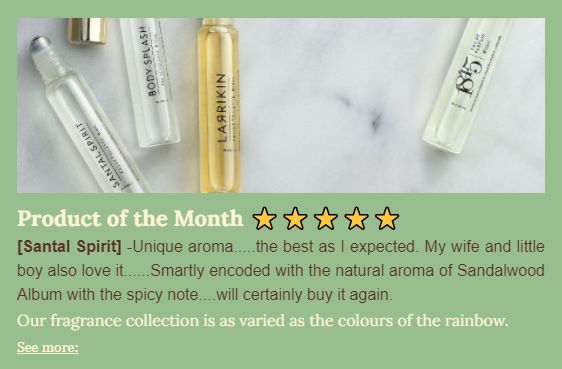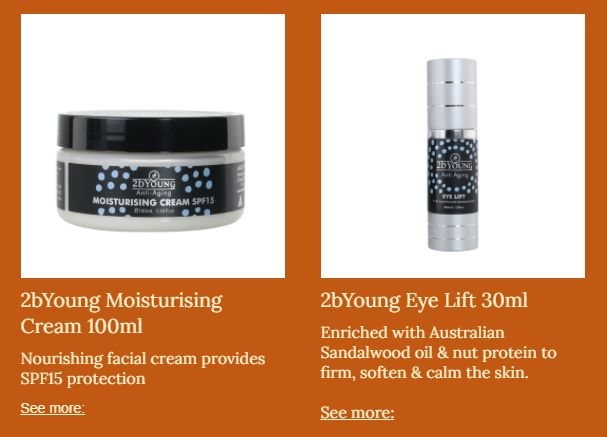Indian sandalwood and Western Australian sandalwood both fall in the ‘Santalum’ family, a fascinating genus with a wide spectrum of genera and species. You may be surprised to find that our beloved native quandong tree, where the delicious quandong jam is made from is technically classed in the Santalum or Santalaceae family. While still a ‘hemi-parasitic tree’ its wood though, is not fragrant like the others from within the family.
Traditionally the most well-known and used sandalwood species has always been the Indian sandalwood, or Santalum album. A tropical climate species with a long history of use in India and the Far East. Over time due to scarcity of traditionally available, ethical, and sustainable stocks, Santalum spicatum, a native Australian dry climate species has been increasingly used as a substitute for incense feedstock, and to some degree as extracted fragrance oil. Besides growing in different habitats, the two key compounds known as alpha and beta-Santalols are another differentiating element between the album and spicatum species.
This key organic compound, or active constituent known as alpha-Santalol is said to provide most of sandalwood’s therapeutic qualities, with benefits experienced via inhalation or topical application. Studies have shown when applied, it influences the parasympathetic nervous system, serving to reduce anxiety and enhance relaxation along with a host of dynamically associated benefits. Beta-Santalol, is the other major active organic compound that provides sandalwood’s creamy, woody aroma and therapeutic properties. The different ratios of these two Santalols is the main distinguishing factor between the album and spicatum species. Indian sandalwood contains around 70-90% of these major compounds, while Australian sandalwood is typically around 20-40%. Going by the alpha and beta Santalol content in the oils as a quality measure for all the sandalwood species around the globe, Santalum album is the clear winner. Therefore, it is not surprising to find that in Traditional Chinese Medicine (TCM) and in agreeance with Chinese Pharmacopeia, the album is the stated species for use in this area as medicine. This is also the reason why the album species is difficult to replace in perfumery, as its strength as a fixative in the perfumery and cosmetic industry is unsurpassed- able to be used for delicate scents that are hard to replace and often extremely rare or fragile.
Another key difference between spicatum and other Santalum species is the fact that dead wood of spicatum still has a woody fragrance, furthermore it is unique in that the naturally occurring white sapwood does not require removal for oil distillation. In comparison when Indian sandalwood logs are harvested for oil extraction, the additional step of removing sapwood is needed, as the sapwood is known to impact the quality of oil. This difference can be perceived as a competitive advantage, perhaps already recognised in the market as the spicatum species has progressively filled the void for sandalwood demand for making incense.
Edible nuts are another obvious distinguishing feature between these two sandalwood varieties. The nuts from the spicatum species has long been apart of the Indigenous Australian diet as a bushfood, highly nutritious and creamy in texture. These Australian sandalwood nuts are rich in ximenynic and oleic acid. Ximenynic acid has been identified as a potent anti-inflammatory agent that helps improve micro-circulation with microvascular kinetic properties which could be beneficial in conditions such as varicose veins. (Bombardelli et al, 1994). Other research conducted has found that the sandalwood seed oil naturally supresses sebum secretion and reduces fat deposition under skin. Oleic acid on the other hand is a type of fatty acid commonly found in other premium cosmetic oils such as almond and olive. Therefore, this distinguishing feature between the two species means that the Santalum spicatum nut oil represents vast potential for use as a novel cosmetic ingredient.
It can be argued that Indian sandalwood’s warm, rich, sweet and luxurious woody fragrance is valued like no other for its distinct olfactive properties, especially as a base note. The spicatum has a different olfactive profile, often described as having more of a sharp, raw earthy woody aroma. Whichever scent profile you prefer, sandalwood’s long lasting and lingering scent profile means that it is a favourable ingredient in perfumery.
Sandalwood as an aroma is certainly difficult to replace, its been mentioned that up to half of the perfumes made globally since 1790, contain sandalwood notes. Back in 1921, perfumer Ernest Beaux incorporated aliphatic aldehydes in the formulation of Chanel No.5 perfume. It was the first time that a perfume with a synthetic ingredient became a hit, perhaps creating future possibilities for synthetics in the eyes of perfumers. The availability of these lower cost synthetic chemicals which imitated nature certainly facilitated the ability of perfume makers to reach the mass market. With rising costs of sandalwood as an ingredient, coupled with industry skulduggery to access the diminishing stock, due to overwhelming demand and overharvesting, natural sandalwood was increasingly substituted by synthetics over the decades.
More recently, the balance between natural and synthetic is beginning to tilt towards the natural path. With increasing global uncertainty in climate and health, escalating environmental problems, consumer attention is now peaked towards the more natural way of life, as individuals seek to reduce impact on the environment.
This rising wave of what can be termed as ‘responsible consumerism’, where people tend to be more informed, does inadvertently affect the flow of funds or choice of products. With more blogs and visible discussions on the natural aspects of sandalwood as a botanical input in skincare and perfume, marketers have picked up on this ‘natural trend’, where manufacturers work to introduce naturally derived ingredients or synthesize molecules to be identical to the natural compounds found in plants.
In recent years, Australian grown stocks of sustainable and ethically produced Indian sandalwood are slowly coming onto the market. This is true for both Santalum album, grown up north in tropical Kununurra and the Santalum spicatum, supported by established plantations and wild stocks naturally found throughout parts of Australia. Such traceable sources of sandalwood, album and spicatum alike will not only serve to rekindle demand for quality sandalwood oil, more markets will also emerge in time with new innovations and wellness applications.
Whether a question of economy or preference, supply or demand, some perfumers certainly believe that natural sandalwood fragrance can never be replaced by synthetics.
In simple terms, molecules will only continue to derive from petrochemicals if consumer demand exists and persists. After all, synthetic biology is often not more sustainable, perhaps the truth lies in the performance pudding. The historical uses of sandalwood by ancient cultures throughout the ages have always presented to us the real value of genuine, unadulterated sandalwood.
E Bombardelli, G Guglielmini, P Morazzoni, P Curri, S.B and W Polinelli, ‘Microvasculokinetic activity of ximenynic acid ethyl ester’, Fitoterapia, 1994, 65, 195-201
Hongratanaworakit T, Heuberger E, Buchbauer G, ‘Evaluation of the effects of East Indian sandalwood oil and alpha-santalol on humans after transdermal absorption’, Planta Med, Jan 2004, Vol 70 (1), P3-7 [doi: 10.1055/s-2004-815446. PMID: 14765284]
D S Hettiarachchi, Y Liu, S Jose, M R Boddy, J E D Fox & B Sunderland, ‘Assessment of Western Australian sandalwood seeds for seed oil production’, Australian Forestry [School of Pharmacy, Curtin University of Technology], 2012, Vol 75 (4), p.246-250



